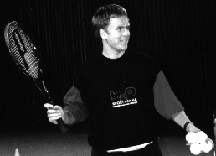|
Juniors Lessons
The Right Approach to Tennis Drills, Part Three
PrefaceI have spent the last two years working full time on a computer program, Computer Tennis - Practice Drills, which contains a number of practice drills (http://www.buller.se/usr/stefan.lundgren/ell-hs.htm). This work has lead to many questions and many rewarding discussions with knowledgeable tennis persons all over the world. During these two years I have also given a number of lectures on the subject practice drills, and these discussions and lectures are the basis of this series of articles. Contents
Part Three: Thoughts about kids practiceDemanding on the coach: Every coach who has given kids (sometimes called minitennis or tinytots) classes can agree that it is mentally tough. Not as much physically as mentally. Children this age demand constant attention, and something has to happen all the time in order for the practice to be interesting. At the same time it is very stimulating to give kids classes, since, as a coach, you can see fast results and get an honest feedback from the pupils. Coaching kids classes is also a privilege, since you get to work with the future of the club. The right equipment: In order to give the pupils the opportunity to succeed, it is important that the right equipment is chosen for the practice sessions. The right racket size, the right balls and the right net are all important factors. Take advantage of their interest: It is vital to be attentive as a kids coach. When working with these categories of players, you have to take advantage of their impulsive actions. If a player would like to practice, for instance, the serve, you have to put your own planning aside and take advantage of the interest the pupil is showing. Show the right way: Make sure that you stand the right way when showing, for instance, a forehand swing. If you stand facing the player, nine times out of ten you can be certain that he/she will hit a backhand instead of a forehand, since the player believes that you have hit the ball on that side of the body. Instead you should stand with your back against the player, so that you go through the motions on the same side of the body as the player. If you practice with a player who does not play with the same arm as you, it is preferable that you play with your non-dominant hand. Throw the ball the right way: If you are not practicing something that demands that throwing the ball with an overhand throw, you should always throw it with an underhand throw. This facilitates for you as a coach, since it is easier to get the ball where you want it, and for the pupil, since the ball arrives with a lower and often slower bounce. Keep the soft balls: Remember that soft balls are important in order to learn technique and ball handling properly. Often the players want to play with regular balls, since they have seen them being used on television.. Instead, try to make the practice with soft balls as fun as possible, for instance by playing for points on a minitennis court. Listen to the pupils: Keep in mind that kids and minitennis players always speak their minds. You get immediate feedback if the practice is fun or not, and a fun practice session is of course a must for the learning process. Do not ruin the player's image of tennis: If a youngster comes to practice after having watched a player on television who, for instance, plays with a circular swing or plays serve and volley, he/she probably wants to try this out. Do not ruin this young player's image of tennis by saying that this is too difficult. Instead you should encourage the initiative. One problem with very young players might be that they insist on playing with a regular ball all over the court after having watched television. This is the way they imagined their practice session and often they are disappointed when it does not turn out that way. As a coach you often hear, "Can't we play real tennis?" By not using too many rigid drills and letting the players hit over the net an easy way, the problem can be avoided. Send email to the author We encourage you to email your comments (pro, con, appreciative, whatever)
directly to the author. To send email to Stefan Lundgren,
click here. Back to TennisONE Home Page webmaster@tennisone.com
|
